During earthworks for a sewer line remains of a linear pottery culture settlement were uncovered in 1972. This settlement can be assigned to the young stone age (Neolithic). The oldest traces of settlement testify that in this area people lived here around 7,000 years ago. If you follow the paved road for about 1 km (Herrenweg) to the Northwest, you come to this place where once the village 'Thiermondingen' was situated. At the crossroads, a sign informs you about the 1008-1526 settlement, of which today only the name 'Dermedinger Wäldle' remains.
Over a length of almost 1,000 meters, an approximately 25 m-wide strip was uncovered here in 1972 for a sewer line. Here, four settlement parts were cut, which were visible through dark places in the clay soil. In the exposed soil pits came to light, which probably have been used for the extraction of clay for housing construction and then as waste pits. These pits were shards of different colour, size and wall thickness. Ribbon-like lines and line decorations attracted special attention and are typical for the period of the so-called 'pottery' (approx. 5,700 - 4100 BC).
Some dark spots of 20-40 cm diameter post holes are identified as remains of timber structures of the 'pottery' community.
Apart of stones and fragments at the forest floor you can not find anything from the medieval settlement of ‘Thiermondingen’ and the Chapel of St. Nicholas. The 'Ingen' place of birth mentioned in many documents of the 11-15th centuries (settlement of Thiermund with his people) may have arisen in the Adrienne time (3rd/4th 7th/8th century) as well as Emmendingen, Denzlingen, Gundelfingen. The first time 'Thiermondingen' was mentioned in a description dates back to a hunting right by King Henry II for the Bishop of Basel.
In the hallway called 'Dermedinger Wäldle' the name of the village of completely missing still continues.
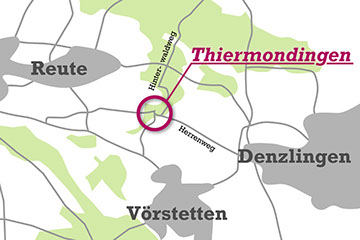
The settlement 'Thiermondingen' was once in the middle of the villages of Reute, Vörstetten and Denzlingen.


Zur Bandkeramiker-Siedlung im Gewann Benzenbühl
Einige der im Gewann Benzenbühl gefundenen Scherben erwiesen sich als Reste von grauschwarzen, besonders dünnwandigen Gefäßen, in die bandartige Linien- und Strichverzierungen eingeritzt sind. Auf Grund dieser Scherbenfunde konnte die Siedlung zeitlich dem Neolithikum zugeordnet werden, der Zeit also, in der die Anfänge der Haustierhaltung und des Ackerbaus zur Sesshaftigkeit und zur Anlage erster dörflicher Siedlungen führten.

Abb.: Zwei Scherben aus der Bandkeramiker-Siedlung im Gewann BenzenbühlAuch eine Pfeilspitze aus Feuerstein wurde im Gewann Benzenbühl gefunden; sie kann als Nachweis der Jagdtätigkeit gewertet werden. Nach dem Ausweis der Fundstellen muss sich die Bandkeramiker-Siedlung beiderseits des Herrenweges erstreckt haben. Sie gilt als eine der größten ihrer Art am Oberrhein.
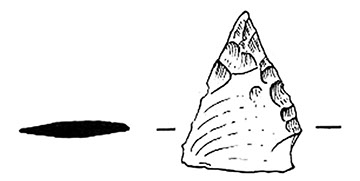
Abb.: Pfeilspitze aus Feuerstein; Fundstelle: BenzenbühlAuszüge aus den Schriftquellen zur Geschichte von Thiermondingen
1008: Der Wortlaut der ersten Erwähnung in der Wildbann-Beschreibung König Heinrichs II. lautet: …Zaringen et inde ad Gondaluingen et inde ad Wersteten et de illo loco ad Thiermondingen, inde vero ad Ruthin ac postea ad Bezscingen…
…
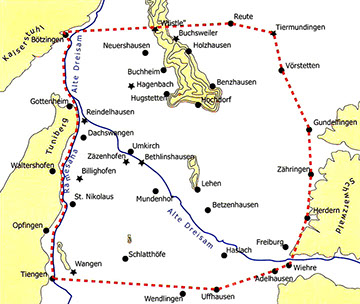
Abb.: Die Karte zeigt den Verlauf der Grenzlinie des Wildbanns von Zähringen über Gundelfingen, Vörstetten, Thiermundingen und Reute nach Bötzingen1136 (28. Oktober): Erwähnung des Ortsnamens Dirmuntingen
1276: Das Kloster Schuttern übergibt den Hof zu Diermundingen dem Landkomtur des Deutschordens (Lantcomentúre ze Elsaz un ze Burgundun un ze Brischowe). Auch die zur Ortschaft gehörige Nikolaus-Kapelle wird durch Meister Kuno von Hügelheim, Rektor der Kirche zu Vörstetten, dem Deutschorden übertragen.
1526 (Auszugsweise Beschreibung des Thiermondinger Hofes: Michel Günther von Verstetten erhält den Dürmundinger Hoff mitsamt Scheuren, Aeckher, Matten, Holtz, Waldt, Wunn und Waydt … zu einem rechten, ewigen und steten Erb für sich und seine Nachkommen, darzu das Guth, genannt das Scherlin, stoßend an den Stripfelgraben und uff deren von Verstetten Allmendt ... so man gen Schupfholtz gandt und stoßend uff die Schürmatten. Item stoßend zur anderen Seiten uff Schupfholtzer Güther uff den Boetzenhofer Acker, uff dem Heerweg, der von Dentzlingen gen Holtz Reutti geht, ziehend vom Heerweg die Güther hinab uff den Reutters weg untz an die Glotter.
Die Gedenktafel
Der Text der Gedenktafel, die im Jahre 2008 an der Wegkreuzung (1 km nordwestlich vom Standort) angebracht wurde, lautet:
Hier befand sich einst die Siedlung
Thiermondingen
mit einer Nikolaus-Kapelle.
1008 in einer Urkunde König Heinrichs II. erwähnt,
bis 1276 im Besitz des Klosters Schuttern,
dann Besitz der Freiburger Deutschherren.
1512-1733 blieb nur der „Diermondinger Hof“ übrig
und bis heute der Name „Dermendinger Wäldle“.
Zum 1000jährigen Jubiläum
am 9. November 2008 errichtet
von der Gemeinde Vörstetten
 Autor dieses ArtikelsDieter Geuenich
Autor dieses ArtikelsDieter Geuenich Quellen / CopyrightsVideo: Animation, Illustration Karte Thiermondingen
Quellen / CopyrightsVideo: Animation, Illustration Karte Thiermondingen
Quelle: Medienhaus Denzlingen, Foto Patrick DirrZur Bandkeramikersiedlung im Benzenbühl:Josef SCHNEIDER, Fundbericht bei den Ortsakten des Landesdenkmalamtes Freiburg (jetzt Regierungspräsidium Freiburg, Referat 26, Denkmalpflege).Dieter GEUENICH – Dieter OHMBERGER, Denzlingen, Band 1: Von den Anfängen bis zum Dreißigjährigen Krieg (Denzlingen 2013), S. 13-15 und zur Lage des Gewanns Ben(t)zenbühl: S. 25 Gemarkungskarte S. 100 (C1).Dieter GEUENICH, Denzlingen, eine alemannische Siedlung im Breisgau (Freiburg 1983) S. 47 und S. 104 (Gemarkungskarte).Christel BÜCKER, Die Vörstetter Gemarkung in der Ur- und Frühgeschichte, in: Vörstetten, ein Dorf im Wandel der Zeit, hg. von Gerhard A. Auer, Dieter Geuenich und Axel Verderber (Vörstetten 1993) S. 9-33, hier S. 12-16.Karl J. NARR, Artikel „Bandkeramik“, in: Reallexikon der Germanischen Altertumskunde, Band 2 (Berlin – New York 1976) S. 30-33.Zum abgegangenen Ort Thiermondingen:Dieter GEUENICH, Thiermondingen. Eine vergessene Siedlung im nördlichen Breisgau, in: „‘s Eige zeige“. Jahrbuch des Landkreises Emmendingen für Kultur und Geschichte 25 (Emmendingen 2011) S. 8-16 (mit Quellen- und Literaturnachweisen).Dieter GEUENICH, Die abgegangene Siedlung Thiermendingen, in: Vörstetten, ein Dorf im Wandel der Zeit, hg. von Gerhard A. Auer, Dieter Geuenich und Axel Verderber (Vörstetten 1993) S. 72-77.Zur Wildbannbeschreibung König Heinrichs II. von 1008, in der der Name Thiermondingen erstmals genannt wird:Thomas ZOTZ, Siedlung und Herrschaft im Raum Freiburg am Ausgang des 11. Jahrhunderts, in: Freiburg 1091-1120. Neue Forschungen zu den Anfängen der Stadt, hg. von Hans SCHADEK und Thomas ZOTZ (Archäologie und Geschichte des ersten Jahrtausends in Südwestdeutschland, Band 7, Sigmaringen1995) S. 49-78, hier S. 62 f.Martin STROTZ, Die frühesten Erwähnungen von Gundelfingen und Wildtal, und Dieter GEUENICH, Die Geschichte des Breisgaus bis zur Ersterwähnung Gundelfingens im Jahre 1008, in: Gundelfingen und Wildtal. Die Geschichte beider Orte zum 1000jährigen Jubiläum Gundelfingens (Gundelfingen 2008) S. 90-104 bzw. S. 84-89 (alle Beiträge mit Quellenangaben und Kartendarstellungen der Wildbannbeschreibung).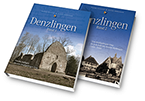 BuchempfehlungDie spannende Ortschronik der Gemeinde Denzlingen.Erhältlich bei
BuchempfehlungDie spannende Ortschronik der Gemeinde Denzlingen.Erhältlich bei
• Buchhandlung Losch
• Schreibwaren Markstahler
• Rathaus Denzlingen
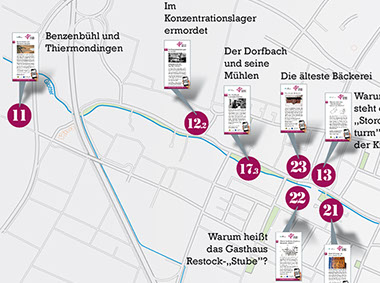


Für alle Geocacher
Display 11:
N 48° 04’ 23.9”
E 007° 51’ 17.5”Display 12.2:
N 48° 04' 15.5”
E 007° 52' 11.4”Display 17.3
N 48° 04' 11.8”
E 007° 52' 21.1”Display 22
N 48° 04' 09.3”
E 007° 52' 31.4”Display 23
N 48° 04' 10.0”
E 007° 52' 29.8”

Für alle Geocacher die ganz genauen Positions-Daten:
Display 11:
N 48° 04’ 23.9”
E 007° 51’ 17.5”
























